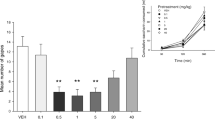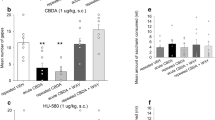Abstract
Rationale
The purpose of this study was to evaluate the potential of oral combined cannabis constituents to reduce nausea.
Objective
The objective of this study was to determine the effect of combining subthreshold oral doses of Δ9-tetrahydrocannabinol (THC) and cannabidiolic acid (CBDA) on acute and anticipatory nausea in rat models of conditioned gaping.
Material and methods
The potential of intragastric (i.g.) administration of THC, CBDA, or combined doses, to interfere with acute nausea-induced conditioned gaping (acute nausea) or the expression of contextually elicited conditioned gaping (anticipatory nausea), was evaluated.
Results
For acute nausea, i.g. administration of subthreshold doses of THC (0.5 and 1 mg/kg) or CBDA (0.5 and 1 μg/kg) significantly suppressed acute nausea-induced gaping, whereas higher individual doses of both THC and CBDA were maximally effective. Combined i.g. administration of higher doses of THC and CBDA (2.5 mg/kg THC-2.5 μg/kg CBDA; 10 mg/kg THC-10 μg/kg CBDA; 20 mg/kg THC-20 μg/kg CBDA) also enhanced positive hedonic reactions elicited by saccharin solution during conditioning. For anticipatory nausea, combined subthreshold i.g. doses of THC (0.1 mg/kg) and CBDA (0.1 μg/kg) suppressed contextually elicited conditioned gaping. When administered i.g., THC was effective on its own at doses ranging from 1 to 10 mg/kg, but CBDA was only effective at 10 μg/kg. THC alone was equally effective by intraperitoneal (i.p.) and i.g. administration, whereas CBDA alone was more effective by i.p. administration (Rock et al. in Psychopharmacol (Berl) 232:4445–4454, 2015) than by i.g. administration.
Conclusions
Oral administration of subthreshold doses of THC and CBDA may be an effective new treatment for acute nausea and anticipatory nausea and appetite enhancement in chemotherapy patients.



Similar content being viewed by others
References
Bolognini D, Rock EM, Cluny NL, Cascio MG, Limebeer CL, Duncan M, Stott CG, Javid FA, Parker LA, Pertwee RG (2013) Cannabidiolic acid prevents vomiting in Suncus murinus and nausea-induced behaviour in rats by enhancing 5-HT1A receptor activation. Br J Pharmacol 168:1456–70. doi:10.1111/bph.12043
Grill HJ, Norgren R (1978) The taste reactivity test. I. Mimetic responses to gustatory stimuli in neurologically normal rats. Brain Res 143:263–279
Hazekamp A, Ware MA, Muller-Vahl KR, Abrams D, Grotenhermen F (2013) The medicinal use of cannabis and cannabinoids--an international cross-sectional survey on administration forms. J Psychoactive Drugs 45:199–210
Hesketh PJ, Van Belle S, Aapro M, Tattersall FD, Naylor RJ, Hargreaves R, Carides AD, Evans JK, Horgan KJ (2003) Differential involvement of neurotransmitters through the time course of cisplatin-induced emesis as revealed by therapy with specific receptor antagonists. Eur J Cancer 39:1074–1080
Hickok JT, Roscoe JA, Morrow GR, King DK, Atkins JN, Fitch TR (2003) Nausea and emesis remain significant problems of chemotherapy despite prophylaxis with 5-hydroxytryptamine-3 antiemetics. Cancer 97:2880–2886
Limebeer CL, Vemuri VK, Bedard H, Lang ST, Ossenkopp KP, Makriyannis A, Parker LA (2010) Inverse agonism of cannabinoid CB1 receptors potentiates LiCl-induced nausea in the conditioned gaping model in rats. Br J Pharmacol 161:336–349. doi:10.1111/j.1476-5381.2010.00885.x
Malik IA, Khan WA, Qazilbash M, Ata E, Butt A, Khan MA (1995) Clinical efficacy of lorazepam in prophylaxis of anticipatory, acute, and delayed nausea and vomiting induced by high doses of cisplatin. A prospective randomized trial. Am J Clin Oncol 18:170–175
Nesse RM, Carli T, Curtis GC, Kleinman PD (1980) Pretreatment nausea in cancer chemotherapy: a conditioned response? Psychosom Med 42:33–36
Parker LA (2014) Conditioned flavor avoidance and conditioned gaping: rat models of conditioned nausea. Eur J Pharmacol 722:122–33. doi:10.1016/j.ejphar.2013.09.070
Parker LA, Mechoulam R (2003) Cannabinoid agonists and antagonists modulate lithium-induced conditioned gaping in rats. Integr Physiol Behav Sci 38:133–45
Parker LA, Mechoulam R, Schlievert C, Abbott L, Fudge ML, Burton P (2003) Effects of cannabinoids on lithium-induced conditioned rejection reactions in a rat model of nausea. Psychopharmacol (Berl) 166(2):156–62
Parker LA, Rock EM, Sticht MA, Wills KL, Limebeer CL (2015) Cannabinoids suppress acute and anticipatory nausea in pre-clinical rat models of conditioned gaping. Clin Pharmacol Ther 97:559–61. doi:10.1002/cpt.98
Razavi D, Delvaux N, Farvacques C, De Brier F, Van Heer C, Kaufman L, Derde MP, Beauduin M, Piccart M (1993) Prevention of adjustment disorders and anticipatory nausea secondary to adjuvant chemotherapy: a double-blind, placebo-controlled study assessing the usefulness of alprazolam. J Clin Oncol 11:1384–1390
Rock EM, Limebeer CL, Mechoulam R, Piomelli D, Parker LA (2008) The effect of cannabidiol and URB597 on conditioned gaping (a model of nausea) elicited by a lithium-paired context in the rat. Psychopharmacol (Berl) 196:389–95
Rock EM, Bolognini D, Limebeer CL, Cascio MG, Anavi-Goffer S, Fletcher PJ, Mechoulam R, Pertwee RG, Parker LA (2012) Cannabidiol, a non-psychotropic component of cannabis, attenuates vomiting and nausea-like behaviour via indirect agonism of 5-HT(1A) somatodendritic autoreceptors in the dorsal raphe nucleus. Br J Pharmacol 165:2620–34. doi:10.1111/j.1476-5381.2011.01621.x
Rock EM, Kopstick RL, Limebeer CL, Parker LA (2013) Tetrahydrocannabinolic acid reduces nausea-induced conditioned gaping in rats and vomiting in Suncus murinus. Br J Pharmacol 170:641–8. doi:10.1111/bph.12316
Rock EM, Limebeer CL, Navaratnam R, Sticht MA, Bonner N, Engeland K, Downey R, Morris H, Jackson M, Parker LA (2014a) A comparison of cannabidiolic acid with other treatments for anticipatory nausea using a rat model of contextually elicited conditioned gaping. Psychopharmacol (Berl) 231:3207–15. doi:10.1007/s00213-014-3498-1
Rock EM, Sticht MA, Parker LA (2014b) Effect of Phytocannabinoids on Nausea and Vomiting. In: Pertwee E (ed) Handbook of Cannabis. Oxford Scholarship, Oxford, pp 435–454
Rock EM, Limebeer CL, Parker LA (2015) Effect of combined doses of Δ(9)-tetrahydrocannabinol THC) and cannabidiolic acid (CBDA) on acute and anticipatory nausea using rat (Sprague- Dawley) models of conditioned gaping. Psychopharmacol (Berl) 232:4445–54. doi:10.1007/s00213-015-4080-1
Thamm DH, Vail DM (2007) Aftershocks of cancer chemotherapy: managing adverse effects. J Am Anim Hosp Assoc 43:1–7. doi:10.5326/43.6.toc
Tomiyasu H, Takahashi M, Fujino Y, Ohno K, Tsujimoto H (2010) Gastrointestinal and hematologic adverse events after administration of vincristine, cyclophosphamide, and doxorubicin in dogs with lymphoma that underwent a combination multidrug chemotherapy protocol. J Vet Med Sci 72:1391–1397
Acknowledgments
This work was supported by a Natural Sciences and Engineering Research Council of Canada (NSERC) Collaborative Research and Development Grant (CRDPJ 476416–14) to LAP in partnership with Prairie Plant Systems Inc, as well as grants to LAP from NSERC (92056) and Canadian Institute of Health Research (137122).
Author information
Authors and Affiliations
Corresponding author
Rights and permissions
About this article
Cite this article
Rock, E.M., Connolly, C., Limebeer, C.L. et al. Effect of combined oral doses of Δ9-tetrahydrocannabinol (THC) and cannabidiolic acid (CBDA) on acute and anticipatory nausea in rat models. Psychopharmacology 233, 3353–3360 (2016). https://doi.org/10.1007/s00213-016-4378-7
Received:
Accepted:
Published:
Issue Date:
DOI: https://doi.org/10.1007/s00213-016-4378-7




